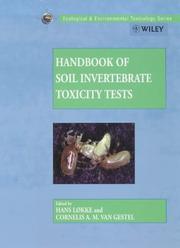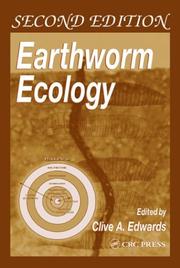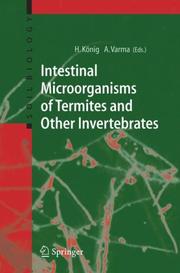| Listing 1 - 10 of 10 |
Sort by
|
Book
ISBN: 0412243105 9400959672 9400959656 Year: 1983 Publisher: London : Chapman and Hall,
Abstract | Keywords | Export | Availability | Bookmark
 Loading...
Loading...Choose an application
- Reference Manager
- EndNote
- RefWorks (Direct export to RefWorks)
Opisthopora --- Annelida --- Ecology --- Écologie --- ecology --- Lumbricidae --- Élevage en masse --- Mass rearing --- Compostage --- Composting --- Facteur édaphique --- Edaphic factors --- Vermiculture --- Lombriculture. --- Oligochaeta --- 631.468 --- Earthworm culture --- Earthworms --- -Lumbricina --- Lumbricus terrestris --- Haplotaxida --- Worms --- Worm farming --- Small animal culture --- Vermicomposting --- Vermiculturists --- Macrofauna and mesofauna. Animals in the soil --- Earthworm culture. --- Ecology. --- -Macrofauna and mesofauna. Animals in the soil --- 631.468 Macrofauna and mesofauna. Animals in the soil --- -Vermiculture --- Lumbricina

ISBN: 0471971030 Year: 1998 Publisher: Chichester Wiley
Abstract | Keywords | Export | Availability | Bookmark
 Loading...
Loading...Choose an application
- Reference Manager
- EndNote
- RefWorks (Direct export to RefWorks)
631.468 --- 615.9 --- Macrofauna and mesofauna. Animals in the soil --- General toxicology. General studies of poisons and poisoning (intoxication) --- Soil invertebrates. --- Toxicity testing. --- Agrotechnology and Food Sciences. Toxicology --- Environmental Toxicology, Ecotoxicology --- Environmental Toxicology, Ecotoxicology. --- 615.9 General toxicology. General studies of poisons and poisoning (intoxication) --- 631.468 Macrofauna and mesofauna. Animals in the soil --- Soil invertebrates --- Toxicity testing --- Poisons --- Toxicological testing --- Toxicology --- Toxicology testing --- Toxicology, Experimental --- Mesofauna --- Invertebrates --- Soil animals --- Testing --- HANDBOOKS --- TOXICITY --- Monograph
Book
ISBN: 0127333509 Year: 1976 Publisher: London ; : Academic Press,
Abstract | Keywords | Export | Availability | Bookmark
 Loading...
Loading...Choose an application
- Reference Manager
- EndNote
- RefWorks (Direct export to RefWorks)
Soil fauna --- Soil animals --- Geographical distribution. --- Variation. --- #ABIB:dd.Prof.R.Dudal --- 631.467 --- 631.468 --- 631.468 Macrofauna and mesofauna. Animals in the soil --- Macrofauna and mesofauna. Animals in the soil --- 631.467 Microfauna. Protozoa. Nematodes --- Microfauna. Protozoa. Nematodes --- Animals --- Soil biology --- Compost animals --- Geographical distribution --- Variation --- Soil animals.
Book
ISBN: 2709905302 9782709905305 Year: 1978 Volume: no 38 Publisher: Paris ORSTOM
Abstract | Keywords | Export | Availability | Bookmark
 Loading...
Loading...Choose an application
- Reference Manager
- EndNote
- RefWorks (Direct export to RefWorks)
Soil fauna --- Sols --- Microbiologie --- 572.7 MORPHOLOGY --- 57 BIOLOGY --- 025.4 CLASSIFICATION --- Soil animals --- 631.467 --- 631.468 --- Animals --- Soil biology --- Compost animals --- 631.467 Microfauna. Protozoa. Nematodes --- Microfauna. Protozoa. Nematodes --- 631.468 Macrofauna and mesofauna. Animals in the soil --- Macrofauna and mesofauna. Animals in the soil --- Soil animals. --- Sols - Microbiologie

ISBN: 084931819X 9780849318191 Year: 2004 Publisher: Boca Raton : CRC Press,
Abstract | Keywords | Export | Availability | Bookmark
 Loading...
Loading...Choose an application
- Reference Manager
- EndNote
- RefWorks (Direct export to RefWorks)
Earthworms --- Ecology --- Congresses --- Lumbricidae --- Taxonomie --- taxonomy --- Biogéographie --- Biogeography --- Physiologie animale --- Animal physiology --- Écologie animale --- animal ecology --- Biotope --- biotopes --- Biologie du sol --- Soil biology --- Déchet --- wastes --- Gestion des déchets --- Waste management --- Compost --- Composts --- 595.142 --- 631.468 --- 591.524 --- Chaetopoda. Polychaeta (bristle worms). Lugworms. Sea-mouse. Myzostomaria. Feather-stars. Oligochaeta. Freshwater worms. Earthworms --- Macrofauna and mesofauna. Animals in the soil --- Special adaptations of animal species to territory (organizational adaptations) --- 591.524 Special adaptations of animal species to territory (organizational adaptations) --- 631.468 Macrofauna and mesofauna. Animals in the soil --- 595.142 Chaetopoda. Polychaeta (bristle worms). Lugworms. Sea-mouse. Myzostomaria. Feather-stars. Oligochaeta. Freshwater worms. Earthworms --- Lumbricina --- Lumbricus terrestris --- Haplotaxida --- Worms --- Composts. --- Ecology. --- Earthworms - Ecology - Congresses
Book
Year: 2021 Publisher: Basel, Switzerland MDPI - Multidisciplinary Digital Publishing Institute
Abstract | Keywords | Export | Availability | Bookmark
 Loading...
Loading...Choose an application
- Reference Manager
- EndNote
- RefWorks (Direct export to RefWorks)
Soil fauna plays a key role in many soil functions, such as organic matter decomposition, humus formation, and nutrient release, modifying soil structure, and improving its fertility. Soil invertebrates play key roles in determining soil suitability for agricultural production and realizing sustainable farming systems. They include an enormous diversity of arthropods, nematodes, and earthworms. However, this fauna suffers from the impact of agricultural activities with implications for the capacity of soil to maintain its fertility and provide ecosystem services. Some agricultural practices may create crucial soil habitat changes, with consequences for invertebrate biodiversity. In the few last decades, especially under intensive and specialized farming systems, a loss in soil ecosystem services has been observed, as a result of the reduction in both the abundance and taxonomic diversity of soil faunal communities. On the other hand, agricultural practices, based on sustainable soil management, can promote useful soil fauna. Therefore, the concerns about the sensibility of soil biota to the agricultural practices make it urgent to develop sustainable management strategies, able to realize favorable microclimate and habitats, and reduce the soil disturbance.
soil biota --- invertebrates --- farming systems --- bioenergy --- biodiversity --- wheat --- ecosystem --- axonchium --- helicotylenchus --- tylenchorhynchus --- pratylenchus --- reniform --- vertosol --- gossypium --- Gossypium --- Zea mays --- vertisol --- Lumbricidae --- Aporrectodea caliginosa --- Aporrectodea rosea --- phosphorus fertilizers --- phosphorus-solubilizing microorganisms --- renewable resources --- heavy metals --- Luvisols --- ground-dwelling arthropods --- pitfall traps --- cover crops --- ecosystem services --- natural enemies --- pear pests --- biological control --- soil organic matter --- soil pH --- post-harvest residues --- crop rotation --- Hordeum vulgare L. --- Vicia faba L. ssp. minor --- soil biodiversity --- vineyard --- co-occurrence patterns --- soil moisture --- soil temperature --- vineyard management --- traditional management --- sustainable agriculture --- management intensity --- South Tyrol --- mountain agriculture --- soil --- soil properties --- macrofauna --- earthworms --- sustainability --- soil invertebrates --- bioindicators --- soil quality --- mesofauna --- soil degradation --- land management
Book
Year: 2021 Publisher: Basel, Switzerland MDPI - Multidisciplinary Digital Publishing Institute
Abstract | Keywords | Export | Availability | Bookmark
 Loading...
Loading...Choose an application
- Reference Manager
- EndNote
- RefWorks (Direct export to RefWorks)
Soil fauna plays a key role in many soil functions, such as organic matter decomposition, humus formation, and nutrient release, modifying soil structure, and improving its fertility. Soil invertebrates play key roles in determining soil suitability for agricultural production and realizing sustainable farming systems. They include an enormous diversity of arthropods, nematodes, and earthworms. However, this fauna suffers from the impact of agricultural activities with implications for the capacity of soil to maintain its fertility and provide ecosystem services. Some agricultural practices may create crucial soil habitat changes, with consequences for invertebrate biodiversity. In the few last decades, especially under intensive and specialized farming systems, a loss in soil ecosystem services has been observed, as a result of the reduction in both the abundance and taxonomic diversity of soil faunal communities. On the other hand, agricultural practices, based on sustainable soil management, can promote useful soil fauna. Therefore, the concerns about the sensibility of soil biota to the agricultural practices make it urgent to develop sustainable management strategies, able to realize favorable microclimate and habitats, and reduce the soil disturbance.
Research & information: general --- soil biota --- invertebrates --- farming systems --- bioenergy --- biodiversity --- wheat --- ecosystem --- axonchium --- helicotylenchus --- tylenchorhynchus --- pratylenchus --- reniform --- vertosol --- gossypium --- Gossypium --- Zea mays --- vertisol --- Lumbricidae --- Aporrectodea caliginosa --- Aporrectodea rosea --- phosphorus fertilizers --- phosphorus-solubilizing microorganisms --- renewable resources --- heavy metals --- Luvisols --- ground-dwelling arthropods --- pitfall traps --- cover crops --- ecosystem services --- natural enemies --- pear pests --- biological control --- soil organic matter --- soil pH --- post-harvest residues --- crop rotation --- Hordeum vulgare L. --- Vicia faba L. ssp. minor --- soil biodiversity --- vineyard --- co-occurrence patterns --- soil moisture --- soil temperature --- vineyard management --- traditional management --- sustainable agriculture --- management intensity --- South Tyrol --- mountain agriculture --- soil --- soil properties --- macrofauna --- earthworms --- sustainability --- soil invertebrates --- bioindicators --- soil quality --- mesofauna --- soil degradation --- land management --- soil biota --- invertebrates --- farming systems --- bioenergy --- biodiversity --- wheat --- ecosystem --- axonchium --- helicotylenchus --- tylenchorhynchus --- pratylenchus --- reniform --- vertosol --- gossypium --- Gossypium --- Zea mays --- vertisol --- Lumbricidae --- Aporrectodea caliginosa --- Aporrectodea rosea --- phosphorus fertilizers --- phosphorus-solubilizing microorganisms --- renewable resources --- heavy metals --- Luvisols --- ground-dwelling arthropods --- pitfall traps --- cover crops --- ecosystem services --- natural enemies --- pear pests --- biological control --- soil organic matter --- soil pH --- post-harvest residues --- crop rotation --- Hordeum vulgare L. --- Vicia faba L. ssp. minor --- soil biodiversity --- vineyard --- co-occurrence patterns --- soil moisture --- soil temperature --- vineyard management --- traditional management --- sustainable agriculture --- management intensity --- South Tyrol --- mountain agriculture --- soil --- soil properties --- macrofauna --- earthworms --- sustainability --- soil invertebrates --- bioindicators --- soil quality --- mesofauna --- soil degradation --- land management
Book
Year: 2021 Publisher: Basel, Switzerland MDPI - Multidisciplinary Digital Publishing Institute
Abstract | Keywords | Export | Availability | Bookmark
 Loading...
Loading...Choose an application
- Reference Manager
- EndNote
- RefWorks (Direct export to RefWorks)
The world of mites, being exceptionally diverse and rich, may be analysed both in historical and geographical terms. It is commonly known that these tiny, ubiquitous invertebrates are found both in terrestrial and aquatic ecosystems; additionally, they are relatively abundant in aeroplankton. The species composition and character of their assemblages vary, and they are different in the polar, temperate and tropical regions. All the above-mentioned factors force scientists to apply a unique approach to research problems and specifically define the aims of their investigations. The Diversity Special Issue on "Biodiversity of Mites" contains complex acarological issues including zoogeographic, ecological and parasitological research conducted in several regions of the world. The results of the presented research concern various taxonomic groups of mites occurring in both terrestrial and aquatic environments. Therefore, they can be an inspiration to search for new research directions and solve contemporary scientific problems.
Research & information: general --- Biology, life sciences --- Zoology & animal sciences --- leaf domatia-mite mutualism --- Coffea arabica --- mite diversity --- edge effect --- South Africa --- Arrenurus --- Lebertia quinquemaculosa --- Lake St. Clair Metropark --- Belle Isle --- Detroit --- phoresy --- mesocosm --- Diptera --- freshwater ecology --- Arctic --- Oribatida --- faunistics --- taxonomic diversity --- distribution --- checklist --- arctic species --- arctic-boreal species --- mites --- Cerambycidae --- natural forest --- Oodinychus --- Trichouropoda --- Monochamus --- Plagionotus --- Tetropium --- oat straw mulch --- barley straw mulch --- biological control --- two-spotted spider mite --- edaphic mites --- lifestyle --- tree related microhabitats --- 18S rRNA --- phylogeny --- ancestral state reconstruction --- sensillus --- Acariformes --- Demodecidae --- Prostigmata --- diversity --- parasites --- Acari --- biogeography --- geographical variability --- Mesostigmata --- neotropical region --- palearctic species --- range of occurrence --- Rotundabaloghia --- species identification --- Uropoda (Phaulodinychus) penicillata --- spring ecology --- crenal diversity --- crenal water mites --- spring morphology --- Astigmata --- Endeostigmata --- climate change --- Svalbard --- COI --- Yucatan Peninsula --- assemblages --- richness --- mesofauna --- prospection --- leaf domatia-mite mutualism --- Coffea arabica --- mite diversity --- edge effect --- South Africa --- Arrenurus --- Lebertia quinquemaculosa --- Lake St. Clair Metropark --- Belle Isle --- Detroit --- phoresy --- mesocosm --- Diptera --- freshwater ecology --- Arctic --- Oribatida --- faunistics --- taxonomic diversity --- distribution --- checklist --- arctic species --- arctic-boreal species --- mites --- Cerambycidae --- natural forest --- Oodinychus --- Trichouropoda --- Monochamus --- Plagionotus --- Tetropium --- oat straw mulch --- barley straw mulch --- biological control --- two-spotted spider mite --- edaphic mites --- lifestyle --- tree related microhabitats --- 18S rRNA --- phylogeny --- ancestral state reconstruction --- sensillus --- Acariformes --- Demodecidae --- Prostigmata --- diversity --- parasites --- Acari --- biogeography --- geographical variability --- Mesostigmata --- neotropical region --- palearctic species --- range of occurrence --- Rotundabaloghia --- species identification --- Uropoda (Phaulodinychus) penicillata --- spring ecology --- crenal diversity --- crenal water mites --- spring morphology --- Astigmata --- Endeostigmata --- climate change --- Svalbard --- COI --- Yucatan Peninsula --- assemblages --- richness --- mesofauna --- prospection

ISBN: 3540281800 9783540281801 3642066380 9786610413089 1280413085 3540281851 Year: 2006 Volume: 6 Publisher: Berlin ; New York : Springer,
Abstract | Keywords | Export | Availability | Bookmark
 Loading...
Loading...Choose an application
- Reference Manager
- EndNote
- RefWorks (Direct export to RefWorks)
Soil microorganisms play a major role in the degradation and recycling of organic material. Microbes are involved in the food web and strongly contribute to soil fertility. In the past, attention was mainly directed towards free-living or particle-bound microorganisms, while the role of intestinal microbes of soil animals has been neglected. For the first time, "Intestinal Microorganisms of Termites and Other Invertebrates" focuses on the microbes in gut systems of soil animals. It starts with a profound overview of the biology of soil invertebrates. A major part deals with the gut microbiota of termites, the best investigated gut system of invertebrates. Termites are important soil processors in tropical and subtropical regions. Insight is given into the intestinal microbiota of further relevant primary litter decomposers, such as earthworms, springtails, millipeds, and woodlice. Novel techniques for studying intestinal microbes complete the volume.
Soil invertebrates --- Intestines --- Termites --- Invertébrés du sol --- Intestins --- Microbiology --- Microbiologie --- Invertébré --- Invertebrates --- Flore microbienne --- microbial flora --- Intestin --- intestines --- Flore du sol --- Soil flora --- Symbiose --- Symbiosis --- Termitidae --- Fonction physiologique --- physiological functions --- Biologie du sol --- Soil biology --- Pédogénèse --- soil genesis --- Soil invertebrates. --- Zoology --- Biology --- Health & Biological Sciences --- Microbiology & Immunology --- Invertebrates & Protozoa --- Microbiology. --- Invertébrés du sol --- EPUB-LIV-FT LIVBIOLO SPRINGER-B --- Dictyoptera --- Isoptera --- White ants --- Mesofauna --- Bacteriology --- Life sciences. --- Ecology. --- Animal physiology. --- Invertebrates. --- Soil science. --- Soil conservation. --- Life Sciences. --- Terrestial Ecology. --- Animal Physiology. --- Soil Science & Conservation. --- Insects --- Termitomyces --- Soil animals --- Conservation of soil --- Erosion control, Soil --- Soil erosion --- Soil erosion control --- Soils --- Agricultural conservation --- Soil management --- Animal physiology --- Animals --- Anatomy --- Balance of nature --- Bionomics --- Ecological processes --- Ecological science --- Ecological sciences --- Environment --- Environmental biology --- Oecology --- Environmental sciences --- Population biology --- Invertebrata --- Microbial biology --- Microorganisms --- Control --- Prevention --- Conservation --- Physiology --- Ecology --- Ecology . --- Pedology (Soil science) --- Agriculture --- Earth sciences --- Physiology. --- Experimental Organisms. --- Soil Science. --- Technique.
Book
Year: 2021 Publisher: Basel, Switzerland MDPI - Multidisciplinary Digital Publishing Institute
Abstract | Keywords | Export | Availability | Bookmark
 Loading...
Loading...Choose an application
- Reference Manager
- EndNote
- RefWorks (Direct export to RefWorks)
The world of mites, being exceptionally diverse and rich, may be analysed both in historical and geographical terms. It is commonly known that these tiny, ubiquitous invertebrates are found both in terrestrial and aquatic ecosystems; additionally, they are relatively abundant in aeroplankton. The species composition and character of their assemblages vary, and they are different in the polar, temperate and tropical regions. All the above-mentioned factors force scientists to apply a unique approach to research problems and specifically define the aims of their investigations. The Diversity Special Issue on "Biodiversity of Mites" contains complex acarological issues including zoogeographic, ecological and parasitological research conducted in several regions of the world. The results of the presented research concern various taxonomic groups of mites occurring in both terrestrial and aquatic environments. Therefore, they can be an inspiration to search for new research directions and solve contemporary scientific problems.
leaf domatia–mite mutualism --- Coffea arabica --- mite diversity --- edge effect --- South Africa --- Arrenurus --- Lebertia quinquemaculosa --- Lake St. Clair Metropark --- Belle Isle --- Detroit --- phoresy --- mesocosm --- Diptera --- freshwater ecology --- Arctic --- Oribatida --- faunistics --- taxonomic diversity --- distribution --- checklist --- arctic species --- arctic-boreal species --- mites --- Cerambycidae --- natural forest --- Oodinychus --- Trichouropoda --- Monochamus --- Plagionotus --- Tetropium --- oat straw mulch --- barley straw mulch --- biological control --- two-spotted spider mite --- edaphic mites --- lifestyle --- tree related microhabitats --- 18S rRNA --- phylogeny --- ancestral state reconstruction --- sensillus --- Acariformes --- Demodecidae --- Prostigmata --- diversity --- parasites --- Acari --- biogeography --- geographical variability --- Mesostigmata --- neotropical region --- palearctic species --- range of occurrence --- Rotundabaloghia --- species identification --- Uropoda (Phaulodinychus) penicillata --- spring ecology --- crenal diversity --- crenal water mites --- spring morphology --- Astigmata --- Endeostigmata --- climate change --- Svalbard --- COI --- Yucatan Peninsula --- assemblages --- richness --- mesofauna --- prospection --- n/a --- leaf domatia-mite mutualism
| Listing 1 - 10 of 10 |
Sort by
|

 Search
Search Feedback
Feedback About UniCat
About UniCat  Help
Help News
News